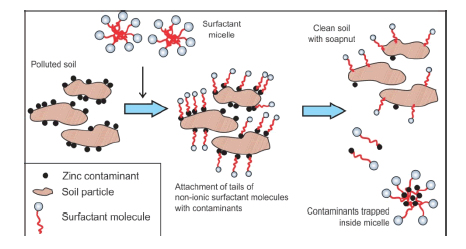Soumyadeep Mukhopadhyay, Sumona Mukherjee, Mohd Ali Hashim, Sahu JN, Nadia Martinez Villegas and Bhaskar Sen Gupta
This study explores the possible application of a biodegradable plant-based surfactant saponin obtained from Sapindus mukorossi or soapnut, for washing zinc from contaminated soil. Batch experiments were conducted by varying pH, surfactant concentration and soil: solution ratio and compared to SDS, a synthetic surfactant. It was observed that soapnut was more efficient than SDS due to its lower pH. Also, the surfactants were more effective at higher concentrations. Soapnut solution removed more than 73% zinc while SDS solution could only wash out up to 31% of the total zinc from the soil under similar experimental conditions. pH played a very important role in zinc removal and at pH 4, both soapnut and SDS removed nearly similar amount of zinc. Analysis of the FT-IR data suggested that saponin did not interact chemically with zinc, offering an option for reusing the surfactant after precipitating the zinc by using NaOH at pH of 10.3. Damage to the soil was found to be negligible. This study concludes that soapnut can be used as a washing agent for removal of Zn from high iron soil with minimal damage to the soil.

Graphical Image: Biodegradable plant-based surfactant.
ఈ కథనాన్ని భాగస్వామ్యం చేయండి